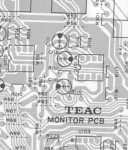LUNE
...a pieds joints
on one of my PCBs i find a capacitor that is not sitting with its polarity the same as the others (edit: i.e., it's in backwards, the actual capacitor is in reverse to what the board has printed). I immediately assumed this must be some kind of capacitor where polarity doesn't matter, but now i wonder. In studying the PCB boards/parts list in my 388 manual I'm coming across 3 different styles of capacitor symbols. can anyone explain to me the exact differences here?
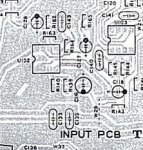 EXHIBIT A: these would be the obvious capacitors with polarity symbols (such as c126- sorry for the bad picture)), it has the dark circle on the negative side and shows a "+" on the positive side.
EXHIBIT A: these would be the obvious capacitors with polarity symbols (such as c126- sorry for the bad picture)), it has the dark circle on the negative side and shows a "+" on the positive side.
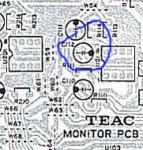 EXHIBIT B: this is the actual capacitor that appears to be in 'backward' (circled blue, C112) , the positive side is in the black dot section. anyway, in this symbol there is no "+" but it appears to be polarized none the less with the black dot on one side. is the polarity on this capacitor important? and what if the capacitor that is in the actual board is in reverse polarity from the symbol on the PCB diagram and the symbol on the actual PCB board? (I got this machine from the original owner and I'm sure he never had it recapped)
EXHIBIT B: this is the actual capacitor that appears to be in 'backward' (circled blue, C112) , the positive side is in the black dot section. anyway, in this symbol there is no "+" but it appears to be polarized none the less with the black dot on one side. is the polarity on this capacitor important? and what if the capacitor that is in the actual board is in reverse polarity from the symbol on the PCB diagram and the symbol on the actual PCB board? (I got this machine from the original owner and I'm sure he never had it recapped)
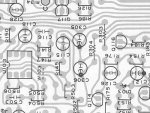 EXHIBIT C: here we have electrolytic capacitors that appear to be polarity inconsequent (such as C115).
EXHIBIT C: here we have electrolytic capacitors that appear to be polarity inconsequent (such as C115).
so can anyone shed a little light on the polarity of EXHIBIT B and why one might have ended up in reverse of all the others? and for curiosity sake, what is the difference between the symbols with the "+" and the ones without.
I am going to be recapping this and it makes me wonder which way i should recap it: the way it was, or the way it "should be" according to the PCB's.
this (monitor) PCB is my best guess to where my "muffled oil in frying pan" sound is coming from. (see: [URL="https://homerecording.com /bbs/showthread.php?p=3311431"]https://homerecording.com/bbs/showthread.php?p=3311431[/URL] )
thanks for any thoughts on the matter.
 EXHIBIT A: these would be the obvious capacitors with polarity symbols (such as c126- sorry for the bad picture)), it has the dark circle on the negative side and shows a "+" on the positive side.
EXHIBIT A: these would be the obvious capacitors with polarity symbols (such as c126- sorry for the bad picture)), it has the dark circle on the negative side and shows a "+" on the positive side. EXHIBIT B: this is the actual capacitor that appears to be in 'backward' (circled blue, C112) , the positive side is in the black dot section. anyway, in this symbol there is no "+" but it appears to be polarized none the less with the black dot on one side. is the polarity on this capacitor important? and what if the capacitor that is in the actual board is in reverse polarity from the symbol on the PCB diagram and the symbol on the actual PCB board? (I got this machine from the original owner and I'm sure he never had it recapped)
EXHIBIT B: this is the actual capacitor that appears to be in 'backward' (circled blue, C112) , the positive side is in the black dot section. anyway, in this symbol there is no "+" but it appears to be polarized none the less with the black dot on one side. is the polarity on this capacitor important? and what if the capacitor that is in the actual board is in reverse polarity from the symbol on the PCB diagram and the symbol on the actual PCB board? (I got this machine from the original owner and I'm sure he never had it recapped) EXHIBIT C: here we have electrolytic capacitors that appear to be polarity inconsequent (such as C115).
EXHIBIT C: here we have electrolytic capacitors that appear to be polarity inconsequent (such as C115).so can anyone shed a little light on the polarity of EXHIBIT B and why one might have ended up in reverse of all the others? and for curiosity sake, what is the difference between the symbols with the "+" and the ones without.
I am going to be recapping this and it makes me wonder which way i should recap it: the way it was, or the way it "should be" according to the PCB's.
this (monitor) PCB is my best guess to where my "muffled oil in frying pan" sound is coming from. (see: [URL="https://homerecording.com /bbs/showthread.php?p=3311431"]https://homerecording.com/bbs/showthread.php?p=3311431[/URL] )
thanks for any thoughts on the matter.
Last edited:


 I guess you thought I was talking about the physical placement of the capacitor design? (as in this one has its positive polarity to the right, this one to the left, this one up or down on the PCB?)
I guess you thought I was talking about the physical placement of the capacitor design? (as in this one has its positive polarity to the right, this one to the left, this one up or down on the PCB?)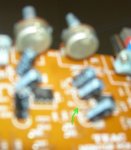

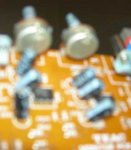
 ).
). 

